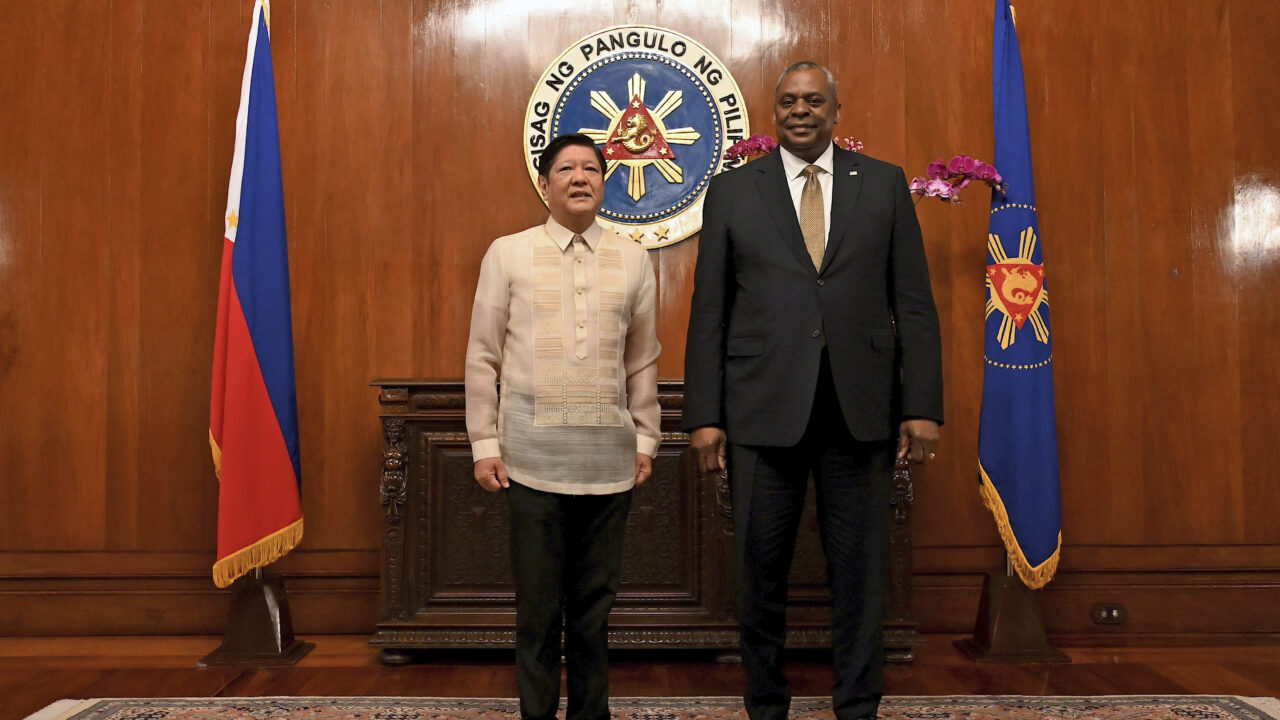US Re-Launches Military Alliance with Philippines
The move is seen as part of a broader plan to counter China in the event that it attacks Taiwan. U.S. Secretary of Defense Lloyd James Austin III poses with Philippine President Ferdinand Marcos Jr. Photo: Jam Sta Rosa / AP.
U.S. Secretary of Defense Lloyd James Austin III poses with Philippine President Ferdinand Marcos Jr. Photo: Jam Sta Rosa / AP.
When Ferdinand Marcos Sr. was presiding over a right-wing authoritarian regime in the Philippines (1965-1986), the United States was one of his closest political and military allies.
After a long break of successive regimes, where the US was cold-shouldered, the Biden administration re-launched in January 2023 its military alliance with the Southeast Asian nation—this time a country headed by Ferdinand Marcos Jr, the son of Marcos Sr.
The US relationship with the government of President Rodrigo Duterte, however, remained strained during his six years in power which ended last year.
The US will now have access to nine military bases, including four new ones under a revitalized “strategic partnership” which is also aimed at neutralizing the rising military power of China and deterring a possible Chinese invasion of Taiwan which Beijing has long claimed as its legitimate territory.
The strained American relationship with China was followed February 4 with the shooting down of a “spy balloon” over US territorial waters, off the state of South Carolina, in a further escalation of the growing confrontation between the world’s two major nuclear powers.
Mao Ning, a spokeswoman for China’s foreign ministry, said: “Out of self-interest, the United States continues to strengthen its military deployment in the region with a zero-sum mentality, which is exacerbating tension in the region and endangering regional peace and stability.”
American officials have long eyed access to the Philippines’ northern territory, such as the land mass of Luzon, as a way to counter China in the event that it attacks Taiwan.
She said, “countries in the region should remain vigilant against this and avoid being coerced and used by the United States”.
Meanwhile, speaking of the new agreement with the Philippines, US Secretary of Defense Lloyd J. Austin III said in Manila: “This is an opportunity to increase our effectiveness and our inter-operability.”
But this new military alliance has also transformed the Philippines into one of the biggest US arms markets in Southeast Asia.
According to published reports, Carlito Galvez Jr., the Philippines’ defense secretary, declined to name the locations of the four additional sites, saying the government needed to consult local officials first.
American officials have long eyed access to the Philippines’ northern territory, such as the land mass of Luzon, as a way to counter China in the event that it attacks Taiwan.
In November, Lt. Gen. Bartolome Vicente Bacarro of the Philippines said that Washington had identified five possible sites, including two in Cagayan, one in Palawan, one in Zambales and one in Isabela. Cagayan and Isabela are in the northern part of the Philippines, with Cagayan sitting across from Taiwan.
According to the US Commercial Service, the trade promotion arm of the US Department of Commerce’s International Trade Administration, the Armed Forces of the Philippines (AFP) already has an ongoing 15-year modernization program (2012-2028), designed to protect defense modernization efforts from shifts in the country’s political climate.
The third milestone (2023-2028) has a hefty projected budget of $4.0 billion dollars, with a long list of military requirements, including fighter aircraft, multirole fighters, ships, unmanned vehicles, intelligence and surveillance systems, communications, personal protective equipment, weapon systems and naval vessels.
The US Government has expressed its intent to make available to the Philippines $100 million in foreign military financing (FMF) to be used by the Philippine Department of National Defense (DND) to fund its armed forces modernization programs.
The strong relationship developed between the Philippines and the US in recent years has contributed for the development of significant opportunities for US defense and security equipment manufacturers and service providers to enhance the Philippines’ self-defense capabilities, the US Commercial Service said January 23.
Key priorities, and potential for US defense contractors include capability to address counterterrorism, maritime domain security, cybersecurity, and internal threats.
According to the Central Intelligence Agency (CIA), the Philippine armed forces (AFP) has approximately 130,000 active-duty personnel (90,000 Army; 25,000 Navy, including about 8,000 Marine Corps; 15,000 Air Force.
As of 2022, the AFP’s primary air and ground operational focus was on internal security duties, particularly in the south, where several separatist Islamic insurgent and terrorist groups operated and up to 60% of the armed forces were deployed.
Additional combat operations were being conducted against the Communist Peoples Party/New People’s Army, which was active mostly on Luzon, the Visayas, and areas of Mindanao; prior to a peace deal in 2014, the AFP fought a decades-long conflict against the Moro Islamic Liberation Front (MILF), a separatist organization based mostly on the island of Mindanao. The MILF’s armed wing, the Bangsamoro Islamic Armed Forces (BIAF), had up to 40,000 fighters under arms
US Senators Jim Risch (R-Idaho), ranking member of the Senate Foreign Relations Committee, and Roger Wicker (R-Miss.), ranking member of the Senate Armed Services Committee, said in a joint statement on February 2: “We applaud the announcement of four new defense sites under the U.S.-Philippine Enhanced Defense Cooperation Agreement”.
Meanwhile, a 1947 Military Bases Agreement gave the United States a 99-year lease on a number of Philippine military and naval bases in which US authorities had virtual territorial rights.
“This arrangement between our two countries highlights our shared commitment to address regional threats and challenges. With the addition of these new military installations, the Philippine government is demonstrating the true value of our alliance to the American people. We appreciate the Marcos Administration for all its efforts to strengthen ties with the United States.”.
“As the leaders of the two principal Senate committees focused on national security, we remain committed to advancing a strong and enduring alliance with the Philippines. There remains, however, much more work to be done to secure the Indo-Pacific against Chinese aggression. We call on the Biden Administration to shore up our deterrent in the region through fully funding the Pacific Deterrence Initiative and accelerating the provision of high-end military capabilities to our allies.”
Meanwhile, a 1947 Military Bases Agreement gave the United States a 99-year lease on a number of Philippine military and naval bases in which US authorities had virtual territorial rights. In August 1951, a mutual defense treaty (MDT) was signed between representatives of the Philippines and the United States.
An amendment to the bases agreement in 1966 reduced its 99-year term to 25 years. In 1979, after two years of negotiation, the bases agreement was renewed with some amendments.
A “Fact Sheet” released by the White House during Vice President Kamala Harris’ visit to the Philippines in November 2022 said the 2014 Enhanced Defense Cooperation Agreement (EDCA) builds on the 1951 Mutual Defense Treaty and 1999 Visiting Forces Agreement.
The agreements provide a legal basis for Philippine and American service members to undertake security cooperation exercises, pursue joint and combined military training activities, and rapidly respond to humanitarian assistance and disaster relief efforts from agreed locations in the Philippines on a rotational basis.
US and Philippine forces have also used EDCA sites during Kamandag and Balikatan military exercises. The United States has allocated over $82 million towards EDCA implementation at all five existing locations.
This investment, and forthcoming additional allotment, will complete 21 projects, enabling the United States and the Philippines to build lasting security infrastructure to promote long-term modernization, build a credible mutual defense posture, maintain humanitarian assistance and disaster relief capabilities, and enhance the strength of the alliance.
New EDCA locations have also been identified to enable the United States and the Philippines to continue to work together towards achieving the agreed objectives under EDCA.
The United States has awarded the vast majority of contracts supporting these projects to Philippine companies, generating economic growth in local Philippine communities and building lasting friendships between the United States and the Philippines.
Your support matters…Independent journalism is under threat and overshadowed by heavily funded mainstream media.
You can help level the playing field. Become a member.
Your tax-deductible contribution keeps us digging beneath the headlines to give you thought-provoking, investigative reporting and analysis that unearths what's really happening- without compromise.
Give today to support our courageous, independent journalists.






You need to be a supporter to comment.
There are currently no responses to this article.
Be the first to respond.